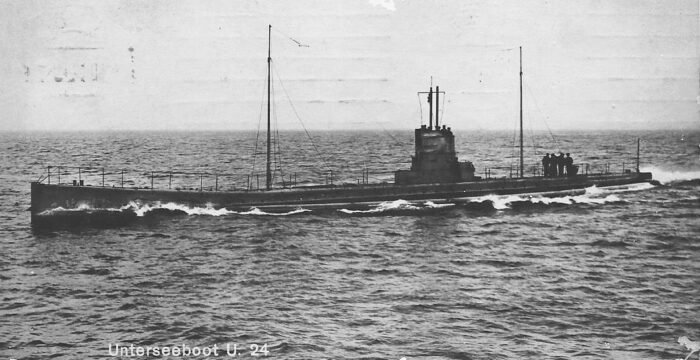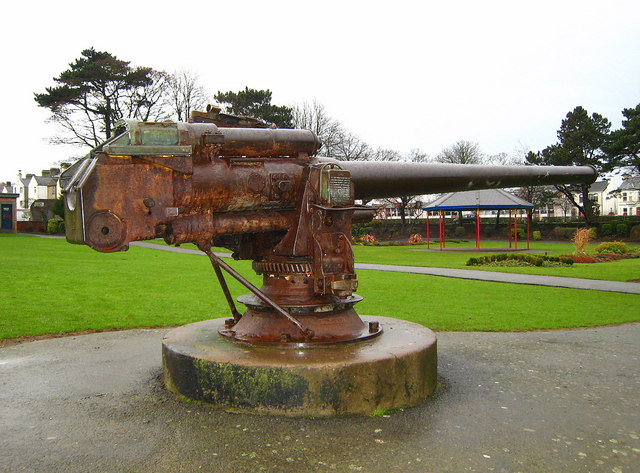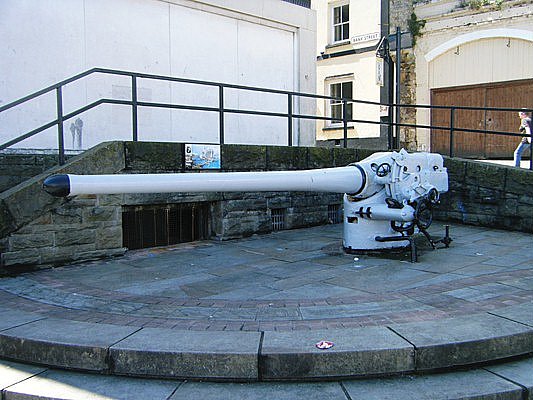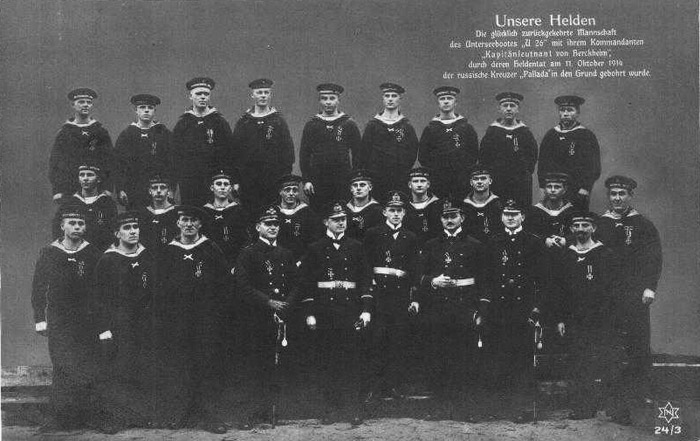 Germany: SM U23, 24, 25, 25 (1912)
Germany: SM U23, 24, 25, 25 (1912)WW1 German U-Boats
Brandtaucher | Forelle | U-1 | U-2 | U-3 class | U-5 class | U-9 class | U-13 class | U-17 class | U-19 class | U-23 class | U-43 class | U-57 class | U-63 class | U-87 class | U-93 class | U-139 class | U-142 class | UA | UB-I class | UB-II class | UB-III class | UC-I class | UC-II class | UC-III | Deutschland | UE-I class | UE-II class | U-ProjectsThe U23 class submarine were of the so-called double-hulled type, designed as oceanic models in official design documentation. They were also called the “mittel-U”, second class equipped with Diesels, and a copy of the U19 by Germaniawerft, from the large imperial shipyard of Kiel. The latter recovered the MAN license and conceived its own diesels, six cylinders two-stroke.
The latter gave 100 hp more than the U19′ MANs, with a surface speed being increased to 16.7 knots. The diving speed was also higher as well as the autonomy.
They were also heavier, equipped with a double-hull and able to dive to 50 meters with a dive time of 2 minutes and 13 seconds.
They had only one 88 mm gun, but in 1915, a second was added, even a 105 mm on some units. The U27 class (4 units in 1913) built in Danzig had an improved diving time of 80 seconds.
Next was the U31 class, developed in 1914, was designed by Germaniawerft as a war series of 11 boats, the last being launched in November 1914. They were a little heavier but similar to the U27. Lastly, the still similar U35 class followed, by far the one with the best score of WWI or any war: 225 ships. U35 was indeeed commanded by the ace of aces Lothar Von A. De la Périere. The Richtofen from the deeps. 12 of these were lost during the war in all combined. This post is about the U23’s technical aspects and career.

Design of the U23 class:
Development
There is not much to say there apart these submarines were a follow-up of the diesel-powered U19 class, by rival and Imperial yard at Kiel. As said in the introduction, the yard managed to purchase the licence and create it’s own variant of the MAN diesels, with more power. The type was called “mittel U” as in official documentation they were designated as “medium range” oceanic types. There were indeed plans for larger submarines even at that early point. So close before the start of WWI it’s important to remember Germany was still the underdog as far as submarines went. The UK, France, Italy, Russia, all had more submarines in service and invested sooner in their development.
Tirpitz’s initial reluctance or even disdain for these was started to shift, and this cautionary, small scale and incremental approach was both economical and well-advised as the product that could be built in wartime was well refined. As said above, the U19 class led to the U27 and eventually the U31 class, which all combined, having the advantage of being ready when the war start, combined the greatest tally of WWI submarines for this type at least. The other record in numbers, not tonnage, were obtained by tiny UB-II types. The UB-III combined 521 ships (1,123,211 GRT) and 7 warships, but they were far more numerous and cheaper to build.
Hull and general design
The U23 class was 64.7 meters long and 6.32 meters wide, with a draft of 3.45 meters, displacement of 669 tons surfaced, 864 tons submerged, more than the U19. The crew was the same however and amounted to 35 men, including four officers.
The 8.8 cm gun was supplemented by another 8.8 cm gun in 1916.[2][1][5]
64.7 m (LOA)
Beam 6.32 m
Draft (max.) 3.45 m
Displacement surfaced: 669 t
submerged: 864 t
Powerplant
The engines for surface cruising were two 6-cylinder 2-stroke diesels with a total output of 1,324 kW (1,800 hp), built at the Germania shipyard, Kiel. Two SSW twin Modyn electric motors had a total of 883 kW (1,200 hp), for underwater travel and for speed of 16.7 knots surfaced, 10.3 knots underwater. Operating radius was up to 9,910 nautical miles (8,910 km) surfaced. When submerged the had a cruising speed of 5 knots, and reached a 85 nautical miles (85 km) at that allure.
Maximum diving depth was 50 meters, like the U19.
Armament
The U23 class had two torpedo tubes each at the bow and sternloke their predecessors, still of the new 50 cm caliber (21 inches) for a total which diverged between sources, from six to ten torpedoes. The norm however seems to have been six torpedoes carried in all, including four pre-loaded, and two bow tubes reloads. As four the four extra torpedoes, it should be considered as an error. There was no internal room. Only possibility was to have them installed below the deck in the wet interdeck over the pressure hull, but even that was impractical.
There was a single 8.8 cm gun like their predecessors, but this was augmented to two of these.
Torpedo Tubes
Germany started by equipping its torpedo boats and early U-Boats of the 1890s with the 35cm (14 in) C35/91 and C35/91GA, then 45cm (17.7 in) C45/91 Br, C45/91S, C/03 and C/03 D were reserved for surface ships, and the C/06 and C/06 D for U-Boats from U3 onwards. They stayed standard before tthe introduction of the 50 cm. The initial model was reserved for surface ships. This was the (19.7″) G/6 and G/6D whic used either the Decahydronaphthalene (Decalin) or Kerosene Wet-Heater. The U23 was the first to introduce the new and famous G7 (entering service in 1913), repeated by the U23 class and follow-up classes. Still, there important stocks of G/6 and it’s possible they were used for training or tests. The Kerosene powered G/6D was considered too “temperamental” for submarine use indeed. The G/6 was developed from 1908 and entered service in 1911. The Royal Navy was slower on this chapter, only introducing the 21″ (53.3 cm) Marks II, II* and II** for submarine use from 1914 onwards.
The four 500 mm (19.7 inches) torpedo tubes could be reloaded from above via the larger hatches going through the outer upper hull.
G/6 specs
Weight unknown, 236 in (6.000 m) lenght overall
Warhead 353 lbs. (160 kg) TNT/Hexanitrodiphenylamin (Hexanite) mixture
Range/Speed 2,410 yards (2,200 m) at 35knots or 5,470 yards (5,000 m) at 27 knots
Power: Decahydronaphthalene (Decalin) Wet-Heater
More on navweaps
G7 Torpedo
The G7 was designed in 1910 and entered service in 1913. Originally designed for surface ships, but in 1917 it started to be used on U-boats.
Specs:
Weight: 3,009 lbs. (1,365 kg)
Overall Length: 276 in (7,020 m)
Explosive Charge: 430 lbs. (195 kg) Hexanite warhead
Range/Speed settings: 4,370 yards (4,000 m)/37 knots and 10,170 yards (9,300 m)/27 knots
Power: Decahydronaphthalene (Decalin) Wet-Heater
8.8 cm Schnelladekanone Länge 30 naval deck gun

Frm the U19 onwards, the classic 3,7 cm or 5cm deck guns were ditched out and as U19 was considered large and stable enough to have a larger gun installed and a single 88mm 27 caliber TK L/30 C/08 deck gun was installed forward. For this the deck was reinforced but no sponsons extensions appeared seemingly on photos.
In 1916, after captains reported this gun still weak, notably to scuttle a boarded ship or engage an armed trawler. They spent way too much time sinking their prey, which called for enemy reinforcements. Thus, all four boats had a second 8,8 cm deck gun installed aft, making two. U19 was the first U-Boat class with two guns, fore and aft.
The U23 class followed this trend, but ultimately only U25 had two. At least this gave the crews a fighting change when surfaced. U24, 25 exchanged both guns for a single 10.5 cm/43 TK L/45 C/16 deck gun in 1918. The 8.8 cm became the standard go-to gun for all U-Boats built afterwards, until the U87 class (launched 1916), generally two for oceanic boats, one for minelayers and for later coastal subs. They accounted for many of their preys.
The 8.8 cm SK L/30 gun used the Krupp horizontal sliding block, or “wedge” and the submarine deck version was on either a retractable or fixed pivot mount. The Krupp mount retracted vertically through a hatch, and the Erhardt version folded down onto the ship’s deck. They avoided underwater drag and turbulences. It seems U19 class had the Ubts.L of the second type.
The 8.8 cm SK L/30 was a widely used naval gun on World War I pre-dreadnoughts, cruisers, coastal defence ships, avisos, submarines and torpedo boats in both casemates and turrets as well.
This caliber became so ubiquitous in the German Navy it was still a favorite for WW2 U-Boats as well starting with the Type VII. Read more
Specs 8.8 cm SK L/30 on Ubts.L mount
Weight: 644 kilograms (1,420 lb)
Overall length: 2.64 meters (8 ft 8 in).
Breech: Krupp horizontal sliding block
Shell: fixed 7 kg (15 lb) cal 88 mm (3.5 in)
Elevation: -10° to +30°
Rate of fire: 15 RPM
Muzzle velocity: 590 m/s (1,900 ft/s)
Maximum firing range: 7,3 km (8,000 yd) at 20° or 10,5 km (11,480 yards) at 30°
10.5 cm SK L/45 naval gun (1918, U24, 25 only)

In late 1918, U24, 25 only had her two 8,8cm deck guns replaced by a single 105mm deck gun with 300 rounds. The crew rose to 35 men less four officers, and now with a proper gunnery officer.
Built by Meddinghaus, this heavy deck gun was designed specially for deck use, low, with many sensible elements protected from corrosion.
Specs 10.5 cm SK L/45
1,450 kg (3,200 lb), 4.725 m (15 ft 6.0 in), 6.8 mm (0.27 in) wide.
Shell 10.5 cm (4.1 in) 25.5 kg (56 lb) fixed Brass Casing 17.4 kg (38 lb)
Breech: Horizontal sliding-block, MPL C/06: -10° to +30° mount
Rate of fire: 15 RPM
Muzzle velocity 710 m/s (2,300 ft/s)
Effective range 12,700 m (41,700 ft) at 30°
⚙ U17 specifications |
|
| Displacement | 669 t surfaced, 864 t submerged |
| Dimensions | 64.7 x 6.32 x 3.45m () |
| Propulsion | 2 shafts MAN diesel engines 1800 hp, 2 × twin Modyn electric motors 1200 hp |
| Speed | 16.7 knots surfaced, 10.3 knots submerged |
| Range | 9,910 nmi at 8 kn surfaced, 80 nmi at 5 kn submerged |
| Armament | 4× 50cm TTs (2 bow, 2 stern, 10 torpedoes), 8.8 cm SK L/40 gun |
| Max depth | 50 m (160 ft) |
| Crew | 4 officers + 31 men |
Career of the U23 class
 U23
U23
U23 was ordered in March 18, 1911, her keel was laid down on December 21, 1911, launched on April 12, 1913 and commissioned on September 11, 1913. Her first commander was LtCdr. Erwin Weisbach until November 25, 1914. Next was Hans Adam, until December 17, 1914 and Lt.Cdr Egenolf von Berckheim, January 12, 1915 and her last commander was Hans Schultheß until her loss in July 20, 1915.
U 23 made total of 16 combat patrols during the war, sinking 7 merchant (total tonnage 8,822 GRT) but other sources states only three patrols.
U 23 met her end on July 20, 1915 when the trawler Princess Louise, towing the British submarine C 27, sighted U 23. The trawler’s captain informed the British submarine, which released the tow line, fired a torpedo, but missed its target. The trawler’s crew feigned abandoning their ship in an apparent panic, but the German submarine commander saw the ruse. When Princess Louise hoisted the war battle flag, opened fire, C 27 fired a second torpedo and hit U 23 behind the conning tower. She sank near the Scottish island of Fair Isle, with 24 of the crew on board.
 U24
U24

U24 was ordered on March 18, 1911 like her brethens at Kaiserliches werft in Kiel, keel laid down on December 21, 1911. She was launched on May 24, 1913, and commissioned on December 6, 1913 under Lt. Cdr. Rudolf Schneider until replaced by Lieutenant Commander Walter Remy on June 4, 1916 until July 10, 1917 when replaced bt Otto von Schubert until August 1, 1917, then Waldemar Haumann (date unknown), Max Bräutigam, Bruno Krumhaar in March-April 1918, then von Beulwitz, Ernst Bücker and Kurt Ledderhose by July 1918.
U-24 made a total of 26 combat patrols, and sank 33 merchant ships (tonnage 105,732 GRT) plus a warship at 15,250 tons. Other (or 34 ships, 106,122 GRT+ a warship). Three ships were als damaged (total 14,318 GRT) and one 1,925 GRT captured as a prize.
On October 26, 1914, she started by torpedoing an unarmed merchant ship without warning., Amiral Ganteaume, badly damaged and towed to a port. On 31 December 1915, U-24 sank HMS Formidable in the English Channel, off the Isle of Portland with two torpedo hits. 547 went down with her. This ws her greatest success.
On June 28, 1915, she sank the transport Armenian (8,825 GRT) off Cornwall with artillery and torpedoes. 29 went down including US mule drivers, and 1,400 mules for the US Army.
On August 19, 1915, U-24 sank the large steamer Arabic (15,801 GRT) (White Star Line) without warning, off the Old Head of Kinsale, southern Irish coast. 44 went down including two Americans, but this was not as severe as the Lusitania.
From August 24, 1917, she was relegated for training. After peace was signed, she was passed on to Great Britain as a war prize, by November 22, 1918, scrapped in Swansea in 1922.
 U25
U25
U25 was built by Germaniawerft in Kiel, ordered on March 18, 1911, her keel was laid down on May 7, 1912, launched on July 12, 1913 and commissioned May 9, 1914 under Kapitänleutnant Otto Wünsche until 15 September 1915, replaced by Kapitänleutnant Alfred Saalwächter until 22 October 1917, Kapitänleutnant Emil Heusinger von Waldegg until 29 December 1917. On 14 combat missions she sank 21 merchant ships (total tonnage 14,126 GRT). According to other sources, three missions. Postwar she was handed over to France, 23 February 1919, scrapped in Cherbourg, 1921/22.
Her greates kills” were British steamer Guido (2,093 GRT) on July 8, 1915, Norwegian coal steamer Nordaas (1,110 GRT) on July 9, 1915, Norwegian sailing ship Norman (1,060 GRT) on August 7, 1915, Norwegian transport Albis (1,431 GRT) on August 14, 1915, Norwegian steamer Bras (1,851 GRT) on August 19, 1915.
 U26
U26

U26 was built by Germaniawerft, Kiel, ordered on March 18, 1911, her keel laid down on May 31, 1912, she was launched on October 16, 1913 and commissioned on May 20, 1914. She was deployed in the Baltic when the war broke out, deployed against the Russian Navy. She was present in the Bay of Riga in August 1914, making a screen with other U-Boats to protect the flanks of the German advance. In 15 patrols, she only sank two merchant ships (2,849 GRT) (other source, single patrol, 5 ships (15,075 GRT) including the Fråck, Petshora, and Zemlya.
On September 28, up to October 11, 1914, KptLt. Berckheim torpedoing the 7,775-ton Russian armored cruiser Pallada off the Gulf of Finland, 16.5 nautical miles from Russarö. Her amunition stores detonated and she sank minutes with 597 men, first Russian heavy loss of the Russian Navy in that war. On June 4, 1915, she sank the Russian minelayer Yenisei. On August 16, 1915, the minesweeper No. I. By August 11, 1915, she departed Libau to patrol the Gulf of Finland and was never heard of again. Last signal was on August 30, southwest of Dagerort. She was reported sunk by the British submarine E9 when submerged or struck a Russian mine on August 31. Her wreck was identified by divers in May 2014, not far from her earlier victim, Pallada.
Read More/Src
Books
Bodo Herzog: Deutsche U-Boote 1906–1966. Erlangen: Karl Müller Verlag, 1993, ISBN 3-88199-687-7, S. 47.
Eberhard Möller/Werner Brack: Enzyklopädie deutscher U-Boote Von 1904 bis zur Gegenwart, Motorbuch Verlag, Stuttgart 2002, ISBN 3-613-02245-1, S. 29.
uboat.net, englisch, abgerufen am 1. August 2024.
Bodo Herzog: Deutsche U-Boote 1906–1966. Erlangen: Karl Müller Verlag, 1993, ISBN 3-88199-687-7, S. 67.
Ulf Kaack: Die deutschen U-Boote Die komplette Geschichte, GeraMond Verlag GmbH, München 2020, ISBN 978-3-96453-270-1, S. 36.
Bodo Herzog: Deutsche U-Boote 1906–1966. Erlangen: Karl Müller Verlag, 1993, ISBN 3-88199-687-7, S. 101.
Bodo Herzog: Deutsche U-Boote 1906–1966. Erlangen: Karl Müller Verlag, 1993, ISBN 3-88199-687-7, S. 123.
Versenkungsliste von U 25 auf uboat.net englisch, abgerufen am 1. August 2024.
Bodo Herzog: Deutsche U-Boote 1906–1966. Erlangen: Karl Müller Verlag, 1993
Johannes Spieß: Sechs Jahre U-Bootfahrten. R. Hobbing, Berlin 1925.
Johannes Spieß: U-Boot-Abenteuer. 6 Jahre U-Boot-Fahrten. Verlag Tradition Kolk, Berlin 1932 Kriegsabenteuer eines U-Boot-Offiziers. Berlin 1938.
Bodo Herzog, Günter Schomaekers: Ritter der Tiefe, graue Wölfe. Die erfolgreichsten U-Bootkommandanten der Welt. 2.
Gröner, Erich; Jung, Dieter; Maass, Martin (1991). U-boats and Mine Warfare Vessels. German Warships 1815–1945. Vol. 2. Conway Maritime Press.
Rössler, Eberhard (1985). The German Submarines and Their Shipyards: Submarine Construction Until the End of the First World War. Bernard & Graefe.
Werner von Langsdorff: U-Boote am Feind. 45 deutsche U-Boot-Fahrer erzählen. Bertelsmann, Gütersloh 1937.
Carl Ludwig Panknin: Unterseeboot „U. 3“. Verlagshaus für Volksliteratur und Kunst, Berlin 1911
Unterseeboot „U. 9“. Schiffe Menschen Schicksale.
Bodo Herzog: Deutsche U-Boote 1906–1966. Erlangen: Karl Müller Verlag, 1993
Eberhard Möller/Werner Brack: Enzyklopädie deutscher U-Boote Von 1904 bis zur Gegenwart, Motorbuch Verlag, Stuttgart 2002
Ulf Kaack: Die deutschen U-Boote Die komplette Geschichte, GeraMond Verlag GmbH, München 2020
Robert Hutchinson: Kampf unter Wasser – Unterseeboote von 1776 bis heute, Motorbuch Verlag, Stuttgart 2006
Links
on uboat.net/ U19
on navypedia.org/ u23
en.wikipedia.org SM_U-23 (Germany)
on de.wikipedia.org/ U_23 U-Boot 1913


 Latest Facebook Entry -
Latest Facebook Entry -  X(Tweeter) Naval Encyclopedia's deck archive
X(Tweeter) Naval Encyclopedia's deck archive Instagram (@navalencyc)
Instagram (@navalencyc)





 French Navy
French Navy Royal Navy
Royal Navy Russian Navy
Russian Navy Armada Espanola
Armada Espanola Austrian Navy
Austrian Navy K.u.K. Kriegsmarine
K.u.K. Kriegsmarine Dansk Marine
Dansk Marine Nautiko Hellenon
Nautiko Hellenon Koninklije Marine 1870
Koninklije Marine 1870 Marinha do Brasil
Marinha do Brasil Osmanlı Donanması
Osmanlı Donanması Marina Do Peru
Marina Do Peru Marinha do Portugal
Marinha do Portugal Regia Marina 1870
Regia Marina 1870 Nihhon Kaigun 1870
Nihhon Kaigun 1870 Preußische Marine 1870
Preußische Marine 1870 Russkiy Flot 1870
Russkiy Flot 1870 Svenska marinen
Svenska marinen Søværnet
Søværnet Union Navy
Union Navy Confederate Navy
Confederate Navy Armada de Argentina
Armada de Argentina Imperial Chinese Navy
Imperial Chinese Navy Marinha do Portugal
Marinha do Portugal Mexico
Mexico Kaiserliche Marine
Kaiserliche Marine 1898 US Navy
1898 US Navy Sovietskiy Flot
Sovietskiy Flot Royal Canadian Navy
Royal Canadian Navy Royal Australian Navy
Royal Australian Navy RNZN Fleet
RNZN Fleet Chinese Navy 1937
Chinese Navy 1937 Kriegsmarine
Kriegsmarine Chilean Navy
Chilean Navy Danish Navy
Danish Navy Finnish Navy
Finnish Navy Hellenic Navy
Hellenic Navy Polish Navy
Polish Navy Romanian Navy
Romanian Navy Turkish Navy
Turkish Navy Royal Yugoslav Navy
Royal Yugoslav Navy Royal Thai Navy
Royal Thai Navy Minor Navies
Minor Navies Albania
Albania Austria
Austria Belgium
Belgium Columbia
Columbia Costa Rica
Costa Rica Cuba
Cuba Czechoslovakia
Czechoslovakia Dominican Republic
Dominican Republic Haiti
Haiti Hungary
Hungary Honduras
Honduras Estonia
Estonia Iceland
Iceland Eire
Eire Equador
Equador Iran
Iran Iraq
Iraq Latvia
Latvia Liberia
Liberia Lithuania
Lithuania Mandchukuo
Mandchukuo Morocco
Morocco Nicaragua
Nicaragua Persia
Persia San Salvador
San Salvador Sarawak
Sarawak Uruguay
Uruguay Venezuela
Venezuela Zanzibar
Zanzibar Warsaw Pact Navies
Warsaw Pact Navies Bulgaria
Bulgaria Hungary
Hungary

 Bundesmarine
Bundesmarine Dutch Navy
Dutch Navy Hellenic Navy
Hellenic Navy Marina Militare
Marina Militare Yugoslav Navy
Yugoslav Navy Chinese Navy
Chinese Navy Indian Navy
Indian Navy Indonesian Navy
Indonesian Navy JMSDF
JMSDF North Korean Navy
North Korean Navy Pakistani Navy
Pakistani Navy Philippines Navy
Philippines Navy ROKN
ROKN Rep. of Singapore Navy
Rep. of Singapore Navy Taiwanese Navy
Taiwanese Navy IDF Navy
IDF Navy Saudi Navy
Saudi Navy Royal New Zealand Navy
Royal New Zealand Navy Egyptian Navy
Egyptian Navy South African Navy
South African Navy






























 Ukrainian Navy
Ukrainian Navy dbodesign
dbodesign